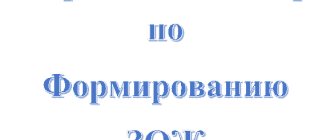MAGAZINE Preschooler.RF
Application of gaming technologies for the development of cognitive activity of preschool childrenIt is known that preschool age is the age of formation and development of the most general abilities, which will improve and differentiate as the child grows older. One of the most important abilities is the ability to cognition.
The federal state educational standard for preschool education defines the tasks of cognitive development:
- development of children's interests, curiosity and cognitive motivation;
- formation of cognitive actions, formation of consciousness;
- development of imagination and creative activity;
- the formation of primary ideas about oneself, other people, objects of the surrounding world, about the properties and relationships of objects of the surrounding world (shape, color, size, material, sound, rhythm, tempo, quantity, number, part and whole, space and time, movement and rest , causes and consequences, etc.);
- the formation of primary ideas about the small homeland and Fatherland, ideas about the socio-cultural values of our people, about domestic traditions and holidays, about planet Earth as the common home of people, about the peculiarities of its nature, the diversity of countries and peoples of the world.
Based on the objectives, the focus of teachers should be the orientation of the educational process towards the cognitive capabilities of the preschooler and their implementation. It is necessary to organize interaction with the child in such a way that it is aimed at developing cognitive interest, cognitive independence and initiative.
The main forms of interaction that promote cognitive development:
- involving the child in various activities;
- use of didactic games;
- application of teaching methods aimed at enriching creative imagination, thinking, memory, and speech development.
Cognitive development involves the cognitive activity of a preschooler. And in order to support cognitive activity, it is necessary to rely on the cognitive interest of children.
Cognitive interest is a selective focus on the knowledge of objects, phenomena, events of the surrounding world, activating the mental processes and activities of a person, his cognitive capabilities.
The main criteria are novelty, unusualness, surprise, and inconsistency with previous ideas.
Cognitive interest consists of the following interrelated processes:
- intellectual - logical actions and operations (analysis, synthesis, generalization, comparison), evidence;
- emotional - the experience of success, the joy of learning, pride in one’s achievements, satisfaction with one’s activities;
- regulatory - volitional aspirations, focus, persistence, attention, decision making
- creative - imagination, creation of new models, images.
In order to ensure the development of the personality of students, it is necessary to create a developing subject-spatial environment in the group. One of the important conditions when creating a developing subject-spatial environment is the correspondence of the material to the age of the children; the materials, complexity and accessibility of their content must correspond to today’s patterns and characteristics of the development of children of a given specific age and take into account those features of development zones that are characteristic of each individual child today.
To form and develop cognitive activity, you should:
- develop the creative abilities of children, create conditions for this,
- strengthen every child’s faith in his own abilities, encourage him, and not weaken his interest with mistrust and negative assessments;
- develop children's self-esteem.
A special place in working with children is occupied by educational didactic games: “Big - small” , “Seasons” , “Which tree is the leaf from” , “Tell me who I am?” , “Help me find my mother” , “Where, whose house?” , “Let’s dress Masha for a walk” , “Run to the named tree” help me familiarize children with animals, birds, natural phenomena, and form knowledge about the environment.
Word games: “Edible - inedible” , “Who is screaming?” , “What’s extra?” , “Recognize by voice” , “Good and bad” , “Who came to us?” and others develop children’s attention, imagination, and increase knowledge about the world around them.
TRIZ technology allows you to raise and educate a child under the motto “Creativity in everything . TRIZ gives children the opportunity to show individuality, teaches them to think outside the box, relieves feelings of constraint, overcomes shyness, and gradually develops fantasy, logic of thinking, and imagination.
“Magic bag” (to the touch)
- “Praise” (two children praise each of their objects)
- “Together” (take turns talking about the subject, adhering to the diagrams)
- “Riddle” (composing a story - a riddle, without naming the subject)
- “Good - bad” or “Pink - black glasses”
- “Wonderful things” (inventing, inventing something new, transferring the properties of one object to another)
- “Come up with a fairy tale” (familiar objects begin to have unusual properties)
A special place in working with children is occupied by games for composing a whole from parts: “Tangram” , “Columbian Egg” , “Vietnamese Game” , “Mongolian Game” . The essence of these games is to recreate on a plane the silhouettes of objects according to an image or design.
A relevant method of cognitive activity for preschool children is experimentation, which is considered as a practical activity of a search nature, aimed at learning the properties, qualities of objects and materials, connections and dependencies of phenomena. In experimentation, the preschooler acts as a researcher who independently and actively explores the world around him, using various forms of influence on it. In the process of experimentation, the child masters the position of the subject of cognition and activity.
Effective methods of cognitive development of preschoolers include project activities that ensure the development of children’s cognitive interests, the ability to independently construct their knowledge and navigate the information space, and the development of critical thinking.
Recently, research activities have been widely used in preschool education, which in its most complete, expanded form presupposes the following:
- the child identifies and poses a problem that needs to be resolved;
- offers possible solutions;
- tests these possible solutions against the data;
- draws conclusions in accordance with the results of the audit;
- applies conclusions to new data;
- makes generalizations.
In preschool age, research activities are aimed at objects of living and inanimate nature through the use of experiments and experiments. Experimentation is carried out in all areas of children's activity: educational activities, play, walking, sleeping, washing. In the process of experimentation, children become familiar with the properties of solid, liquid, gaseous substances, the properties of wood, metal, etc., for example: “Will it float or sink?” , “How does water disappear?” , “Mixing colors” , “Where did the sugar go when I stirred the tea with a spoon?” . Everything is assimilated firmly and for a long time when the child hears, sees and does everything himself.
By older preschool age, the child’s ability to be proactive increases noticeably. This age period is important for the development of the child’s cognitive needs, which is expressed in the form of search, research activities aimed at “discovering” new things, which develops productive forms of thinking. What is crucial for a child’s development is not the abundance of knowledge, but the type of learning in which this knowledge is acquired.
Thus, using gaming technologies, experimentation, cognitive tasks and project activities when solving the problem of cognitive development of preschool children, the teacher ensures a staged transition, qualitative changes in the development of cognitive activity: from curiosity to cognitive activity.
For the development of cognitive abilities, the development of research behavior is of great importance: curiosity, observation, the development of research skills and abilities: the ability to see problems, the ability to ask questions, put forward hypotheses, the ability to classify, the ability to conduct experiments, the ability to draw conclusions and conclusions.
To develop children’s ability to see problems, games and tasks are used: “Continue the story” , “Look at the world through someone else’s eyes” , “Name as many features of an object as possible” ; observations, looking at different objects.
Simple exercises help in the ability to develop hypotheses: “Think about why children love to play?” , “Why does water flow?” and etc.
Observing the world around them, children draw conclusions and conclusions, and the more deeply a child learns the mysteries of the world around him, the more questions he has: “Why?” "For what?" "How does this happen?"
The questions should be exploratory in nature, developing the ability to put forward hypotheses, for example: “Do you think it will rain all day?” , “What do you think will happen if there is no rain at all?” , “Will the snow ever melt?” , “What do you think will happen to insects if they don’t go to bed?” and etc.
A teacher should not give children ready-made knowledge and reveal the truth to them, but teach them to find it. If a child asks a question, try not to give him a ready-made answer, but ask him what he thinks himself. By calling for reasoning and leading questions, the teacher should lead him to find answers and make discoveries for himself, based on existing knowledge and ideas.
Such joint activities and business communication develop children’s intelligence and personality as a whole. Children have a desire to learn new things about the properties of things and actively explore them.
Activities planned outside of class are a mandatory component of the child’s cognitive development system. It is at such events that teachers have the opportunity not only to consolidate, clarify, expand, and systematize children’s accumulated ideas, but also to introduce new content.
Forms of activities held outside of class
- Tradition "Our Glorious Deeds" ;
- Educational evenings;
- Stories from teachers “Did you know...” ;
- Selection of material about animals and plants;
- Collecting.
It is advisable to follow the wise advice of V. A. Sukhomlinsky: “Be able to open one thing to the child in the world around him, but open it in such a way that a piece of life sparkles in front of the children with all the colors of the rainbow. Always leave something unsaid so that the child wants to return again and again to what he has learned .
| Next > |
Development of cognitive processes of a preschooler through play activities.
Lecture for parents
“Development of cognitive processes of a preschooler
through play activities."
“Children’s play often has deep meaning”
Schiller.
Preschool age
– the initial stage of personality formation. Education has a great influence on mental development. By the beginning of preschool age, mental development reaches a level at which it is possible to form motor, speech, sensory and a number of intellectual skills, and it becomes possible to introduce elements of educational activities. Under the influence of training and education, intensive development of all cognitive processes occurs.
One of the important tasks of modern preschool education is the creation of conditions that would contribute to the development of the child and the disclosure of his creative potential.
It's no secret that in preschool children, the development of cognitive processes, such as memory, attention, thinking, speech, is important. Cognitive processes are an integral part of any human activity that provide one or another of its information. They allow a person to outline in advance the goals, plans and content of the upcoming activity, to play out in his mind the course of this activity, his actions and behavior, to anticipate the results of his actions and to manage them as they are performed.
Preschool children need not to be taught, but to be developed. Development is at the forefront. They need to develop through activities accessible to their age - games.
There is nothing more harmonious than a child playing. The power of this harmony is so great that adults watching a child’s play involuntarily smile, experiencing joy and delight. The whole life of a preschool child is permeated with play; this is the only way he is ready to open himself to the world and the world for himself.
A game
- the first activity, which plays a large role in the formation of personality. Play is the leading activity of a preschooler, so it is easier to develop cognitive processes through play. When playing, children concentrate and remember better than when given direct instructions from an adult. In games, children reflect their accumulated experience, deepen and consolidate their understanding of the events depicted, of life. A child, like an adult, learns about the world through activity. Playing games enrich participants with new sensations, ideas and concepts. Games expand the range of ideas, develop observation, intelligence, the ability to analyze, compare and generalize what is seen, on the basis of which to draw conclusions from observed phenomena in the environment.
Play is an indispensable means of replenishing a child’s knowledge and ideas about the world around him, developing thinking, and valuable moral, volitional and physical qualities. In the formation of a child’s diversified personality, games are given the most important place.
To carry out full-fledged education and upbringing of preschoolers, it is necessary to develop cognitive processes - intuition, abstraction, thinking, the ability to solve cognitive problems, and the accumulation of sensory experience.
The main method of development of a preschooler is problem-based - search, and the main form of its organization is play.
Educational games provide an opportunity to develop processes such as attention and memory in preschoolers. Game tasks have a positive effect on the development of ingenuity, resourcefulness, and intelligence. Many games require not only mental, but also volitional efforts: organization, endurance, and the ability to follow the rules of the game.
The game has a great impact on the formation of personality; it is such a conscious activity in which the ability to analyze, compare, generalize and draw conclusions is manifested and developed. Playing games helps children develop their abilities to act, which are important in everyday practical activities.
The development of cognitive or intellectual abilities is influenced by perception, memory and attention. The development of cognitive processes in children is necessary for their preparation for school and further successful learning and intellectual development. But this should be a joint concern of educators and parents.
.
In preschool age, cognitive development is achieved through play, and didactic games
. Didactic games serve as educational tools - children master the characteristics of objects, learn to classify, generalize, and compare. A didactic game makes it possible to solve pedagogical problems in a playful way that is most accessible to preschoolers. The value of didactic games lies in the fact that they are created for educational purposes. Through their use, stronger and more conscious knowledge, skills and abilities can be added. The didactic game awakens children's imagination and creates high spirits. A child, captivated by the game, does not notice that he is learning, although every now and then he is faced with tasks that require mental activity from him.
Didactic games activate cognitive processes, develop cognitive interest, form a desire to learn new things, cultivate strong-willed qualities, and promote the formation of coherent speech.
Most developmental exercises are aimed at simultaneously improving several cognitive processes.
To develop attention
The exercise “Listen and clap” is used. Children are asked to clap their hands when the name of the fruit is heard. For example: wheel, apple (cotton), car, book, pear (cotton), banana (cotton), etc.
Development of thinking
exercises aimed at generalization, highlighting features, and grouping are facilitated. The game “Find the Extra One” asks the preschooler to combine objects based on a common characteristic and point to the extra one. For example, in the series “dog, chicken, cow, cat” the chicken will be superfluous, since it is a bird among animals. The game is adjusted for early preschool age with easier subjects.
For speech development
For children, retelling tasks are suitable, in which the child improves phonemic awareness and pronunciation. To jointly develop speech and imagination, children are asked to come up with their own story.
Development of auditory memory
facilitate exercises that require you to remember words or pairs of words and reproduce them. Visual memory and attention are most easily formed in tasks like: “Here are the objects. Look carefully. Try to remember the location and features. Close your eyes while I rearrange them. Now put the items in the original order.”
Children's imagination
develops in almost any activity: drawing, playing, playing with plasticine. Inviting a preschooler to come up with an image or heroes of the game creates the arbitrariness of the imagination.
Development of visual perception
occurs in the process of the preschooler establishing the shape, color, and size of objects. An excellent option would be exercises with mosaics, puzzles, construction sets, and pyramids. For auditory perception, tasks with sound accompaniment are selected. For example, children need to determine who makes a particular sound.
Role-playing game
is of decisive importance for the development of imagination. Gaming activity influences the formation of arbitrariness of mental processes. Through play, children begin to develop voluntary attention and voluntary memory. When playing, children concentrate better and remember more. The conscious goal (to focus attention, remember and recall) is highlighted for the child earlier and is easiest in the game. The very conditions of the game require the child to concentrate on the objects included in the game situation, on the content of the actions being played out and the plot. The need for communication and emotional encouragement forces the child to focus and remember.
In order for the development of cognitive abilities of preschoolers to be effective, it is necessary not only to correctly select the games and activities necessary for this, but also to interest the child in one activity or another. Only in this case will the development of your preschooler’s cognitive abilities proceed at a rapid pace, and the child’s interest in the world around him will never fade!
“Without play there is not and cannot be full-fledged mental development. A game is a spark that ignites the flame of inquisitiveness and curiosity” V.A. Sukhomlinsky
Cognitive activity plays an important role in the development of a child. It is the basis for the assimilation of the cultural experience of humanity, the most important condition for learning at school, as well as for future creativity.
The changed situation in the development of society leads to the need to restructure the preschool education system, shifting the emphasis from the development of the performer’s personality to the development of an active personality. This leads to a revision of the content of pedagogical activity, which is associated with a rethinking of what to teach and what place the child occupies in this process, what is his activity in the learning process. The requirements of the Federal State Educational Standards (FSES) guide teachers not only to the formation of knowledge within educational fields, but also to the development of an active position in the process of cognition, communication and other types of activities in the educational process.
The problem of the formation of cognitive activity is of particular relevance, since children with low cognitive activity do not show a desire to acquire new knowledge and, as a result, learn poorly. Low cognitive activity is a characteristic feature of children with mental retardation. Meanwhile, Dubovitskaya L.A. believes that the most important feature of children with mental retardation is that most of them need not so much treatment as the creation of special conditions for training and education. The works of M. I. Lisina, A. M. Matyushkin, T. D. Sartorius convincingly prove that cognitive activity is a formable personality quality. Preschool age is considered as a sensitive period for the development of cognitive activity.
Optimizing the cognitive activity of children in the educational process constantly attracts the attention of researchers and practitioners, since there is a need to improve the pedagogical process in preschool institutions. It is quite obvious that the result of cognitive activity is higher when there is a psychologically and pedagogically correct and most appropriate combination of the activity of the teacher and the child in this process.
Having studied the materials presented in the scientific and methodological literature, the following technologies can be used to purposefully develop the cognitive activity of children with mental retardation:
- creating a situation of success (A. S. Belkin)
- problem-based learning technology
- technology of educational games (B. P. Nikitin)
- using the experimentation method (O. V. Dybina)
The combination of two concepts: cognitive activity and children with mental retardation is possible, but only in the case when the child himself is interested, and he can only be interested through play, because play is the leading activity. It is advisable to use games in educational, joint activities, as well as in individual work, and I consider the use of games during independent activities to be the culmination of the work, because the child took the game himself, he needs it, it is interesting, and this means that independence, observation, intelligence , perseverance, constructive skills are formed on personal initiative, and therefore with great effect. Curiosity becomes intellectual at the stage when it turns into interest in a problem, when the question is resolved not by the child asking a question and receiving a ready answer, but by looking for a solution. At this point, curiosity becomes a positive force. Our goal is to support the child in this endeavor, since the child’s independent activity has elements of self-education. In order for self-education to become a means of self-education for a child, we cared not only about children’s interest in new knowledge and the ability to obtain it, but also about the formation of such moral and volitional qualities as the ability to complete a task, work independently, perseverance, teamwork skills, respect for the opinions of other children, etc.
The game gives results if the child plays with pleasure. What game will be equally good as an entertaining moment and as an educational one? Undoubtedly, these are educational games that simulate the creative process and create their own microclimate. The emerging contradiction between pleasure and benefit can be resolved only by modern technologies for the development of intellectual and creative abilities through play, which are widely used in their work. These are Dienesh blocks, Nikitin cubes, Cuisenaire sticks, “Math tablet” , etc. Using various teaching materials, it is necessary to adapt it to the level of development and interests of children.
Didactic games can be divided into 4 groups of gradually more complex exercises:
- to develop skills to identify and abstract properties
- to develop the ability to compare objects according to their properties
- to develop the actions of classification and generalization
- to develop the ability to perform logical actions and operations.
The listed games and exercises, with some exceptions, are given in three versions. Games and exercises of the first option develop in children the ability to operate with one property (identify and abstract one property from others, compare, classify and generalize objects based on it). With the help of games and exercises of the second option, the ability to operate with two properties at once is developed (identify and abstract two properties; compare, classify and generalize objects according to two properties at once). Games and exercises of the third option develop the ability to operate with three properties at once.
These stages are easier to trace on Nikitin’s cubes.
There are several options the Fold the Pattern game
1st – when the child places cubes on the finished image.
If the child can cope, you can offer him to assemble the pattern according to the reduced diagram.
The next stage of the game is drawing up a pattern according to a scheme not divided into cells. So that the child can complete the task, the diagrams are made in full size. If the child finds it difficult, place the cells drawn on transparent film on the diagram for a certain time.
Based on Cuisenaire sticks in the manual by E. A. Nosova and R. L. Nepomnyashchaya “Logic and Mathematics for Preschoolers,” a series of games by age has been developed. To develop children's ability to perform logical actions, the game “Fence” . The game “Fence” develops spatial understanding, lays down initial skills in geometry and drawing, and captivates children, despite its complexity.
The game “Ladder of Numbers” is indispensable in mathematics classes. With its help, the child visually sees the relationship of numbers and the composition of the number, finds subsequent and previous numbers, and the missing number. It is difficult for children to understand why 2 is less than 5, and 3 is more than 1; the numbers simply don’t tell them anything. on the “Ladder of Numbers” , because the strip with the number 2 is shorter than the strip with the number 5, which means it is smaller.
Learning the composition of numbers using the “Number Ladder” is simple and fun. For example, a matryoshka built a bridge across a river, took for this a strip with the number 5 (let it be a log or a board, but they can’t cross with a friend, the bridge is narrow. What to do? The guys will definitely offer to take another board and expand the bridge. We substitute the strips , neither one fits. Or maybe make one out of two? And here the children cannot be stopped, they will definitely help the nesting dolls, find all the variants of the composition of the number 5, clearly see, understand why 5 is exactly 2 and 3, and not 2 and 2, Moreover, it will be remembered better, because the knowledge was given unobtrusively, in a playful way, and the children were guided by interest.
Teaching children to count backwards with the help of the “Ladder of Numbers” is easy and quick; all you have to do is walk back and forth along the ladder several times, and counting down is already mastered.
Count examples, determine the missing or intended number: for example, the teacher says: “I have thought of a number, it is more than 3, but less than 5, the “Ladder of Numbers” is an indispensable assistant in everything , but how many more tasks can you come up with?
Children are characterized by varying degrees, or intensities, of active cognition. E.V. Korotaeva, analyzing psychological and pedagogical features, determined the levels of development of cognitive activity in children.
This work should be carried out in the following order: children who have shown a zero level of cognitive activity should be given individual lessons using a “success situation” . With children who have shown a relatively active level of cognitive activity, use various cards - symbols.
The use of cards allows children to develop the ability to substitute and model properties, the ability to encode and decode information about them. These abilities and skills develop in the process of performing various subject-based game actions. Property cards help children move from visual-figurative to visual-schematic thinking, and cards with property negation become a bridge to verbal-logical thinking.
The use of didactic games and game situations allows for better learning of educational material. Thanks to this, preschoolers become more independent, more active, they are no longer able to work at the reproductive level, but to create. During play, children with mental retardation learn to apply their knowledge in new situations and acquire it independently. The game, being a playful form of learning, allows you to combine the educational and entertaining, and acquire lasting knowledge while playing. That is why the use of gaming technologies makes the learning process interesting and helps to overcome difficulties in mastering the material.
Based on the above, we can conclude that learning is much easier and more productive if gaming technologies are used in the educational process. Children get tired much less during class, become closer to the teacher, and trust him more. After activities that evoke positive emotions in them (and this is what we strive for), they feel more confident.
Cognitive development of preschool children during developmental games
Mental cognitive processes include: perception, attention, imagination, memory, thinking and speech.
Perception is a holistic reflection of an external material object that directly affects the senses.
Attention is a prerequisite for any activity. Attention can be voluntary or involuntary. With voluntary attention, a person sets a goal: to pay attention to a certain object through volitional efforts.
Imagination is a mental process that consists of creating images and situations that have never been perceived.
Memory is the imprinting, preservation, recognition and reproduction of what a person previously perceived, experienced, thought, did. This is the basis of mental life, the basis of our consciousness. The accumulation of experience, its preservation and use is the result of the activity of memory.
Thinking is a generalized, indirect, abstract reflection of the external world and its laws. The operational components of thinking are mental operations - analysis, synthesis, comparison, abstraction, generalization, classification.
There are three types of thinking: visual-effective (learned through the manipulation of objects); visual-figurative (cognized with the help of representations of objects, phenomena); verbal-logical (cognized with the help of concepts, words, reasoning). Of the three types of thinking: verbal-logical, visual-figurative and visual-effective, the last two types are sufficiently developed and predominate in preschool children. As for the first - verbal-logical, this type of thinking in preschool age begins to develop intensively by the age of 6-7 years.
Speech is the process of a person’s practical use of language for the purpose of communicating with other people. Language is a means of communication between people.
Cognitive development involves the development of children's interests, curiosity and cognitive motivation; formation of cognitive actions, formation of consciousness; development of imagination and creative activity; the formation of primary ideas about oneself, other people, objects of the surrounding world, about the properties and relationships of objects of the surrounding world (shape, color, size, material, sound, rhythm, tempo, quantity, number, part and whole, space and time, movement and rest , causes and consequences, etc.), about the small homeland and Fatherland, ideas about the socio-cultural values of our people, about domestic traditions and holidays, about the features of nature, the diversity of countries and peoples of the world.
The main feature of educational games: these are educational games. They contribute to the development of cognitive activity, intellectual operations, which are the basis of learning. But what attracts a child to a game is not the educational task inherent in it, but the opportunity to be active, perform a game action, achieve a result, and win. However, if a participant in the game does not master the knowledge and mental operations that are determined by the learning task, he will not be able to successfully perform game actions. The ability to teach young children through active activities that are interesting to them is a distinctive feature of educational games.
An educational game helps to demonstrate cognitive activity in independent activities, expand one’s own cognitive interests and needs, teaches one to master various methods of safe behavior in the modern information environment, develops the child’s integrative qualities, educates, socializes, entertains, and gives rest.
Thus, the knowledge acquired by the child in classes is consolidated in joint activities, after which it passes into independent and, after that, into everyday activities.
When organizing work to develop cognitive activity, it is advisable to use not only specially made games, but also ordinary objects, so that the child sees that the real world does not exist on its own. To work with children to identify the properties and relationships of objects, use not only classes, but also walks and productive joint activities; for individual work - routine moments (dressing and undressing situations, hygiene procedures, preparation for lunch, bedtime).
Verbal games help develop children's speech: by replenishing and activating the vocabulary, forming correct sound pronunciation, developing coherent speech, the ability to correctly express their thoughts, compose independent stories about objects, phenomena in nature and social life, developing retelling skills. Games such as “Name in one word”, “Name three objects” require children to actively use generic and specific concepts. Finding antonyms, synonyms, words that sound similar is the main task of word games.
Development of children's cognitive activity through educational games:
‒ Thinking operations develop: analysis, synthesis, comparison, generalization, classification;
- The ability to imagine develops;
- Show interest in classes;
- The speech activity of children in various types of activities increases.
Games for classes must be selected taking into account the cognitive material that the children have studied. For mathematics classes, games with mathematical content that require mental effort: puzzle games; joke games; games with interesting questions.
In classes on speech development, games: to develop the ability to “peer” into an object, phenomenon; on the ability to make inferences and assumptions.
In classes to familiarize yourself with the surrounding world, games: to consolidate knowledge about seasonal phenomena, flora and fauna; promoting the development of curiosity and observation.
During the games themselves, depending on the age of the children, it is necessary to ask questions, give a sample of actions, a sample of a statement, remind the rules, referring to the experience of the children, take on the role of a leader or observe the progress of the game.
In the process of gaming activities with children, try to arouse their interest in games, create in them a state of enthusiasm, mental tension, using entertaining problem situations that require resolution.
To organize joint and independent activities of children, it is necessary to create a subject-development environment in the group - a special developmental area with a large range of educational games, taking into account safety, aesthetics, clarity, and accessibility.
Educational games contribute to:
‒ development of cognitive and mental abilities: acquiring new knowledge, generalizing and consolidating it; expanding their understanding of objects and natural phenomena, plants, animals; development of memory, attention, observation; developing the ability to express one’s judgments and draw conclusions;
‒ development of children’s speech: replenishment and activation of vocabulary;
‒ social and moral development of a preschool child: in such a game, knowledge of the relationships between children, adults, objects of living and inanimate nature occurs, in it the child shows a sensitive attitude towards peers, learns to be fair, to give in if necessary, learns to sympathize, etc. .
The structure of an educational game is formed by basic and additional components. The main components include: didactic task, game actions, game rules, result and didactic material. Additional components: plot and role.
Conducting educational games includes:
- Familiarizing children with the content of the game, using didactic material in it (showing objects, pictures, a short conversation, during which the children’s knowledge and ideas are clarified).
- Explanation of the course and rules of the game, while strictly following these rules.
- Show game actions.
- Determining the role of an adult in the game, his participation as a player, fan or referee (the teacher directs the actions of the players with advice, questions, reminders).
- Summing up the results of the game is a crucial moment in its management.
Based on the results of the game, one can judge its effectiveness and whether it will be used by children in independent play activities. Analysis of the game allows us to identify individual abilities in the behavior and character of children. This means properly organizing individual work with them.
Education in the form of a didactic game is based on the child’s desire to enter an imaginary situation and act according to its laws, that is, it corresponds to the age characteristics of a preschooler.
Types of educational games:
‒ Games with objects (toys).
‒ Printed board games.
‒ Word games.
Games with objects are based on children’s direct perception and correspond to the child’s desire to act with objects and thus become familiar with them. In games with objects, children learn to compare, establish similarities and differences between objects. The value of these games is that with their help children become familiar with the properties of objects, size, and color. When introducing children to nature in such games, I use natural materials (plant seeds, leaves, pebbles, various flowers, pine cones, twigs, vegetables, fruits, etc.) - which arouses keen interest and an active desire in children to play. Examples of such games: “Describe this object”, “What is this?”, “What first, what next”, etc.
Printed board games are an interesting activity for children to get acquainted with the world around them, the world of animals and plants, and phenomena of living and inanimate nature. They are varied in type: “lotto”, “dominoes”, “paired pictures”. With the help of board and printed games, you can successfully develop speech skills, mathematical abilities, logic, attention, learn to model life patterns and make decisions, and develop self-control skills.
Word games are an effective method of fostering independent thinking and speech development in children. They are built on the words and actions of the players. Children independently solve various mental problems: describe objects, highlighting their characteristic features, guess them from the description, find similarities and differences between these objects and natural phenomena. During the games, children clarify, consolidate, and expand their ideas about natural objects and its seasonal changes.
Developmental game in experimental activities - contributes to the formation of children's cognitive interest in the environment, develops basic mental processes and observation.
Literature:
- Ananyev, B. G. Cognitive needs and interests / B. G. Ananyev / Uch. zap. Leningrad State University, No. 265; issue 16, Psychology. - L., 1959. - P. 41–60.
- Averin V. A. Psychology of children and adolescents. - St. Petersburg, 1998.
- Bondarenko A.K. Didactic games in kindergarten / A.K. Bondarenko.-M., 1991
- Gamezo M.V., Gerasimova V.S., Gorelova G.G., Orlova L.M. Developmental psychology (Personality from youth to old age): Textbook. - M., 1988.
- Kryzhanovskaya L. M. Developmental psychology. - M., 1997.
- Mukhina V. S. Age psychology. - M., 1998.
- Development in older children of cognitive interest in the history of the objective world in project activities: educational method. Manual/auth.-comp. A. Yu. Kuzina.-Tolyatti: TSU, 2009.-60p.
- Subbotsky, E.V. A child opens the world: A book for kindergarten teachers / E.V. Subbotsky. - M.: Education, 1991. - 207 p.
- Tikhomirova L. F. Development of children's cognitive abilities. A popular guide for parents and teachers. - Yaroslavl: Academy of Development, 1996. - 192 p., ill.







